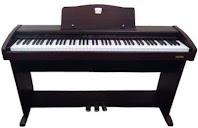 |
| Classenti CDP1 Rosewood |
UPDATED REVIEW – October 5, 2018 – I do not recommend the Classenti CDP1, CDP2, CDP3, or GR1 digital pianos
because they are overpriced and have lower quality technology Chinese key actions (as
compared to the name brands) among other things, in my opinion. When it comes to digital baby grand & vertical pianos, especially in polished ebony cabinets or other attractive colors, they are
without a doubt beautiful to look at. Some are better designed than
others and have better materials & construction, but from the
outside they can look attractive and add beauty in your home. However, there
are some things you need to know about digital pianos, including
the Classenti, before you spend your hard earned money on
one. Firstly, there are NO digital baby grands made in the US. Over 70%
of digital baby grands sold in the world are made in China. The rest of
them are made in Japan, Korea, Indonesia, and a few other countries. This is not a bad thing but just understand this is the way it is.
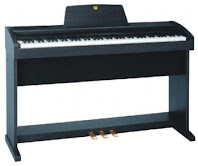 |
| Classenti CDP1 black satin |
In
mainland China, there are well over 30 (maybe more) individual digital piano
& keyboard manufacturers throughout that large country which
produce thousands of instruments for sale domestically and throughout
the world. China is a busy place when it comes to mass producing all
types of musical instruments including digital pianos, keyboards, drums,
guitars, horns, woodwinds, brass, reed instruments, percussion of all
types, and millions of music accessories. In fact, all you would need to
do to go in business for yourself selling digital pianos is to fly over
to China, find the manufacturer(s) and models you want to represent, place
an order and have them ship to your warehouse in the US or whatever country you are in. It also helps
if you can speak Chinese but there are ways around that too:) Of course
you would be required to order a good quantity of pianos at one time and
have a warehouse or large facility to store them, include providing your own
warranty on them, pay for any service calls on ones you’ve sold if they need
service (if a service tech can be found to repair them), and deal with
the manufacturer(s) if there are ever any problems (and there always are
many problems with these kinds of pianos – I have experienced that for
myself. On the plus side as business venture, you get to make money (hopefully) and put your own brand
name on them. The manufacturer will put any name you want on the
piano.
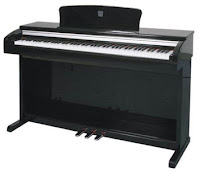 |
| Classenti CDP2 ebony |
So for instance, if you want a nice sounding classical European type name like “Classenti” (I kinda like that name myself) on your Chinese pianos, or any other name for that matter, you can have the Chinese manufacturers put the name on them as well as put the name on the box so it looks official. Whatever name you think would help sell
that piano is fine, as long as no one else is using it:). In the United Kingdom (UK), the Classenti name is available exclusively at UK Pianos in London, England. The owner of the store is the owner of the name Classenti pianos (according to public records) and the operator of that brand. It is not unusual then that he would want to promote and say good things about “his brand.” But the Classenti brand is nothing more than Chinese made digital pianos owned by Chinese companies in China using fairly average Chinese parts. The Classenti GR1 small baby grand is actually the YL700HB from the Tide International company in Shandong, China and also seems to be affiliated with and branded under the PianoNova name. The ClassentiGR1/Tide/PianoNova YL700HB model is quite basic, has a Chinese key action (normally noisy and unreliable based on my experience with similar pianos), limited 64-note polyphony piano sound memory as compared with the actual name brands like Yamaha, limited instrument sounds, no USB output to iPad (a big request these days), no half-damper sustain pedal function (important for students and players), and in my opinion should sell for no more than $2000 (or so) at most compared to other similar Chinese brands like Suzuki, Adagio, etc.
 |
| Classenti CDP3 ebony |
The Classenti CDP1, CDP2, and CDP3 models are from another Chinese digital piano company called PianoNova Piano Manufacture Co.,Ltd in Hubei, China and
Wuhan Zhijia Piano Manufacturer Co., Ltd. (which is affiliated with Piano Nova), and they have their Chinese model numbers of Norma, Lyra, and Pavo (funny names:). PianoNova also sells their digital pianos under their own name (PianoNova) in other countries such as Australia and the factory brand pianos tend to sell for less money than the private labels. However, many of these “off-brand” pianos are priced (US) similarly with name brand pianos including Yamaha, Kawai, Casio, and Roland. So why would anyone want to buy a “no name” piano with average Chinese digital piano technology and key actions not backed up by a known brand name at around the same price as the better name brand pianos? The Classenti CDP/PianoNova pianos are quite basic with only 8 sounds, a 64 note polyphony sound chip with limited dynamic range, Chinese made and designed key action with minimal key senor capability (as opposed to a name brand design including some with triple senor), only a basic MIDI recording feature, no USB direct connect with computer or iPad, and no half-damper pedal system. Do these deficiencies make Classeniti/PianoNova bad pianos…no they don’t. But are there better options in low price ranges?…yes there are.
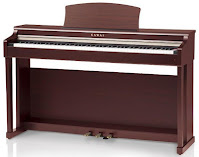 |
| Kawai CN24 |
Personally I always recommend going with a name brand if possible but it’s a free world (for most people) and you can buy whatever they want. The Chinese manufacturers try to make their pianos look like the name brands so people think if they look good and the cabinet design is similar, then they must BE good. In fact, the Chinese made brands are in some cases even more attractive than the “name brands” such as Yamaha, Kawai, Roland, etc, with special cabinet designs and finishes not available in some of the name brands, but that’s one of the reasons these pianos sell, they can look great! But beauty is usually only skin deep and what’s inside (for most people) will likely not match the attractive outside in most of these pianos. That’s true for some people I know as well:)
With regard to warranties on the piano, if it doesn’t come directly from a known manufacturer, then there is always a big risk. Store warranties are always dependent on that store being in business to service and pay for repairs. Retail stores go in and out of business all the time unlike the name digital piano manufacturers such as Yamaha, Kawai, Casio, and Roland. These name brand companies have been in business for well over more than 50 years each and have the ability and longevity to repair and service their digital pianos in the US and around the world. The Classenti piano brand offers a “5-year warranty” but that warranty is not supplied by the manufacturer, it is supplied by the owner of the Classenti brand as are all private label warranties. If that individual ever goes out of business (and many have done so in this worldwide economy including my area of the world), good luck getting any service on the piano under that warranty including refunds or exchanges…not gonna happen. So all I can say about that is…be careful when considering a private brand.
 |
| Worlde digital piano |
Almost
all Chinese-made pianos from Chinese owned companies in China (China is
a VERY big country) such as Hubei Huadu Piano Manufacturer, China Joy
Keyboards Co., Zhongshan Jungang Electronics Co, Changshu Talent Import
& Export, Jinjiang Lida Electronic Co. Ltd., Guangzhou Amason
Electronics Co. Ltd., and many others have some definite things
(features) in common. I have played enough of these less expensive Chinese
made pianos (not all things made in China are of low quality and in
fact many are very good) to know that these commonalities include
attractive cabinets (some of which are not made well), lots of buttons
& features like recording and rhythms, a good size LCD display
screen (sometimes no screen or small LED display instead), and other
things. But unfortunately, as I mentioned earlier, many if not most of these pianos also have low
quality piano sound reproduction with minimal key sensors, low quality
and noisy key action (Chinese made key actions are known for this), low
quality pedal assemblies, small piano polyphony sound chip of 64-notes,
and a basic set of sounds & rhythms which are typically not very
good. Also, many of the Chinese digital pianos are normally not very reliable (based on all my experience and it is substantial) and few piano
technicians are available to repair them.
So
what does this all mean? It simply means that an American or European
sounding piano name name like Adagio, Allegro, Cameron, Adams, Hemingway, Williams, Classenti, Broadway,
and others does not mean the product was made or designed in the US and
has acceptable good quality piano sound, key action, and pedaling. I am
a piano teacher and musician and would not recommend a piano like this to a
student or piano player when so many other good options are available. The Classenti (as well as
other names like this) is created & used to help a retail dealer
sell more pianos to people like me and you because the name sounds
good and the cabinet may look attractive. The Classenti pianos are all Chinese products
designed and made by a Chinese company using (generally speaking) lower quality technology (as compared with name brands)
and also sold through a nice web site
promoting this brand (anyone can have a nice web site with nice pictures:). Also, there is a web site called “sounds musical.com” which according to public records is directly affiliated and/or owned by the owner of the Classenti piano brand. Once again, when it comes to a private label brand on a retail web site owned or run by people associated with that brand, then it’s likely they will be quite enthusiastic about that brand…makes sense:)
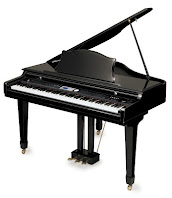 |
| Dynatone digital grand |
When it comes to what’s most important in a digital piano, the piano key action is the most important aspect, and if the key action is not made by Kawai, Roland,
Casio, Yamaha, or the Fatar key action company in Italy, then it will likely be
a low quality, low performance, noisy, and unpredictable key
action…period. I have yet to play a digital piano brand with a Chinese designed and made
key action (and I have played many of them) that is worthwhile or than can reproduce the piano sound
response and dynamics that are necessary based on all my experience. One
day Chinese key actions will likely get better but they are not there
yet.
With regard to Classenti, on their US “corportate” site, the listed price for the Classenti GR1 digital baby grand is shown as $4950. In the world of retail store or web
site prices, because the brand is (according to public records) private and owned by an individual named Graham Stogden (Howard), he has full control
over that name wherever he puts and sells it (like other similar businesses), and he can make up
and quote any prices he wants to. This would be the same for any other
private retail dealer or supplier and is the way business works. But the Classenti web prices are
out of line on their web site compared to what they should be sold for
in my opinion as compared to other Chinese designed and made digital pianos. The GR1 piano should “retail” for no more than $2500 – $3000
based on other similar Chinese pianos out there I’ve seen and should sell for less
than $2000. It doesn’t matter what the specifications and descriptions say, it matter what it really plays & sounds like and I am always skeptical of pianos that are private label brands from other countries that say such glowing things about their own pianos. So in most cases what your really getting is a nice looking cabinet
surrounding very basic digital piano technology found in small low
priced digital pianos. In other words, you are likely buying something
nice to look at at the expense of a having much better instrument in a
non-digital grand style. So is the Classenti piano a BAD
piano? Well no, not necessarily compared with other Chinese made piano products. Is it and other similar brands something of high quality compared to Yamaha,
Roland, Kawai, or Casio pianos?…no, not even close.
| Yamaha YDP162PE |
As an example, when you can purchase a new polished ebony Yamaha YDP162PE for $1699US internet price that has a quiet Yamaha designed GH key action along with a 128-note polyphony including with half-damper pedal system, why would you want to purchase a Classenti polished ebony CDP2 for their web site price of $1950 when it has no brand name recognition, no warranty direct from manufacturer, only 64-note polyphony and much fewer instrument tones, and no half damper pedal system? It just makes no sense, even if the price came down to $1500 or less. It’s like comparing a basic hamburger (CDP2) with a high quality steak (YDP162PE). Now if the Classenti CDP2 was substantially less money (closer to $1000), then maybe it would make sense, but otherwise it does not.
 |
| Broadway digital piano |
On another note and worth mentioning, UK piano owner also has another line of private label digital pianos called “Broadway.” I like that name and I commend him for making up a name that sounds American & musical. In reality the Broadway digital pianos are manufactured by a South Korean company called Dynatone who also produce pianos under their own name (I have played Dynatones in the past and did not like them). But they will also sell you their piano under any name you want and so the Broadway is a name that was created to sell at the UK Piano store. However there are many inexpensive Asian made digital pianos (excluding the name brands) that are available everywhere for much less than $1000. Guitar Center has their own brand with an American name (Williams), Sam Ash has their own brand with an American sounding name (Adams), and so on, all of which I have played and do not recommend. So UK pianos did the same thing, but almost ANY private label brand is typically going to be quite inferior to name brands, have much lower resale value, and will not have a manufacturer warranty. However, even with all of that there will be some people who like the non name brands like Broadway, etc, and that’s certainly OK. It really boils down to selecting whatever you like because it’s your money.
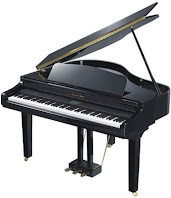 |
| Cameron digital grand |
When it comes to Classenti digital baby grands, I feel you would be much better off if you gave up
the idea of actually getting high quality realistic playing &
sounding digital baby grand designed & produced in China (this
will sound and play nothing like a real grand), and instead buying a
lower priced new very high quality vertical style digital piano in the
$1000-$2500 price range from Casio, Kawai, Yamaha, or Roland. OR, if you
absolutely must have that Baby Grand style, then there are alternatives
to the Classenti and others like it. By the way, I have
not personally played a Classenti piano because they are
not available anywhere for me to play locally except in the UK and that’s a bit far for me to go:). The same situation is true of “Cameron & Sons” digital pianos which is a private label US brand owned by a private individual with the last name of Cameron and is a similar piano to the Classenti brand in a number of ways. Go here to learn more about Cameron & Sons: Cameron & Sons piano review.
Digital features in Chinese designed and produced pianos tend to be very similar. In the final analysis, if you are considering
this brand, be careful that you make an educated decision (and not be sold on just the way they look) before you
make a purchase on this or anything other piano for that matter. When a company is working hard on selling and promoting their “private label” brand likely made by one of those many Chinese piano companies, just remember they usually promote it because it will make them more money and not necessarily because it’s a great piano. When it comes to the latest digital piano technology and piano realism, the brands to buy are the Japanese brands including Yamaha, Casio, Roland, and Kawai, and Korg, and a couple of others. My recommendation is to go with recognized manufacturer/name brands whenever possible.
By the way, to show you the vast difference in technology between a name brand piano and Classenti piano, all one has to do is compare it with the Casio PX850 or Yamaha YDPS51. As an example, the Casio Privia PX850 ($1099US internet price) has 18 very nice instrument sounds and a 256-note polyphony sound chip (highest polyphony you can get), with triple key sensor system as opposed to a small 64 note polyphony and limited key sensor system on the Classenti’s. The Casio PX850 also has a huge dynamic sound range going through a new piano lid speaker projection system, longer pedal piano decay times, piano harmonic overtones, pedal resonance reproduction, half pedal sustain system, synthetic ivory & ebony keytops for better finger playing surface, wav file audio recording instead of simple MIDI (a huge upgrade and useful in piano education), 5 stereo acoustic piano sounds for mellow classical, jazz, pop, and concert. The PX850 also has a high speed USB direct connect to iPad for seamless connectivity for interactive music education or notation using the latest iPad piano apps. The piano is also covered by a manufacturers warranty as opposed to a private label warranty. The new Casio PX850 piano as well as the new Yamaha YDPS51 (which has major digital sound advancements) far surpasses any piano for piano playing realism in the Classenti piano line and far as specifications and their actual playability. So whenever possible based on your budget, put your money into a name brand because the rewards are almost always worth it.
If you want more info digital pianos and lower prices than internet or store discounts, please email me at tim@azpianowholesale.com or call me direct at 602-571-1864





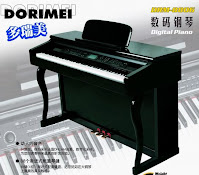
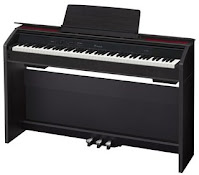










Tim,
You mentioned the value of 256 note polyphony in another post, but I'm not entirely clear on why this is important. Could you explain a bit?
I can see how being able to reproduce 256 separate notes at once might be useful if you were, for example, trying to replicate the layered sound of an entire 100+ piece symphony orchestra on your piano.
But if you're just "a pianist" is there any real benefit to having say 256 vs 128 (or even only 64) voices? If a piano has 88 keys, then at most, you could only generate 88 notes at once (plus maybe a metronome or drum click) and even then you probably wouldn't really 'want' to. Why would you need 256?
As another example, lets say you're trying to model an entire touring rock band on your keyboard. The band consists of lead vocals, two separate rhythm guitars, lead guitar, bass guitar, keyboard, drums, second percussionist, three piece horn section, lead vocalist and three piece backup vocals, for fourteen total musicians. For fun, lets say all the guitarists and keyboardist are each also singing harmonies too.
Adding that up, you've got 18 possible guitar strings, 4 bass strings, 10 keyboard fingers, 4 drum limbs, 2 percussionist limbs, 3 horns, and 7 sets of vocal cords.
That's a maximum of 48 "voices" going at once, and since realistically not everyone is playing with their maximum number of notes at all times, most of the time, its going to be fewer. Is there a reason, why say 64 note polyphony wouldn't be able to "cover" that?
I'm not trying to be a wiseacre; I just don't "get" it. What am I missing here?
The latest digitally sampled piano sounds include having true stereo sampling,sympathetic vibrations, harmonics, pedal damper resonance, and other aspects of acoustic piano sound. Larger polyphony increases the ability of the piano to capture those features, especially more slightly more advanced players as well as be able to capture 2 or more stereo instrument sounds layered together played at one time or in a split mode. 64 note polyphony was fine in the simple older days of digital sampling, but not any longer. That is a major reason why all top digital piano companies are starting to go with 256 note polyphony.
When you talk about "voices" each one of those voices are in the mono mode, not stereo. Once each one of them go to stereo including all percussive sounds in a drum kit, then you immediately double the amount of polyphony necessary just to play basic stereo tones not counting the effects and other things that take away from polyphony. If you are happy on an instrument with 64-note polyphony, then that is all that really counts….happiness:)
To Add up to the polyphony, I have read somewhere that when using the sustain pedal the notes sustained are kept in that polyphony range, so if you could for example press 64 keys and sustain them on a 64 polyphony piano, the piano would not play another note if you press it?
true, but only if the piano sound is not stereo. Many good digital pianos these days have a stereo piano sampled sound which uses 2 notes of polyphony per key which would limit the piano polyphony to no more than 32 notes
Hi,
Honest opinion please!
I have around £800 (approx $1300 US) to spend I was thinking Roland F120, Yamaha YDP 162, YDP S51 or Casio PX850. Also kinda liked Yamaha DGX 650 with all the extra, tho really interested in best piano sound/feel. What do you think? Cheers, Dougie, Scotland.
Hi Dougie,
I would recommend the Yamaha YDP162 or Casio PX850. You could likely be happy with either one. The Roland F120 does not compete well against these two models in my opinion
I have played on theYamaha YDP 142 and also the Broadway B1, which are both priced around £600 and the B1 felt and sounded slightly better to me. So would you still recommend I go for the Yamaha? Thanks, Ish.